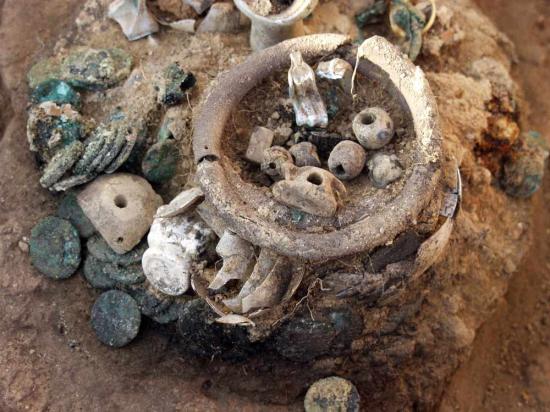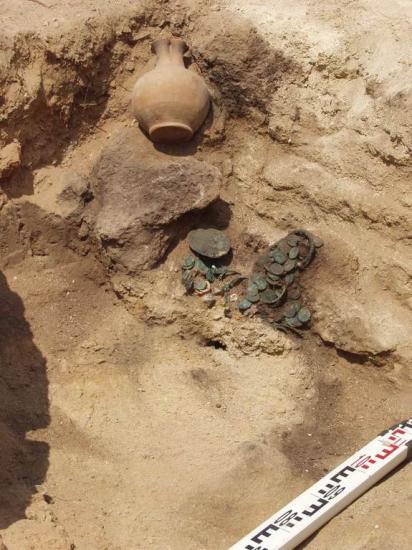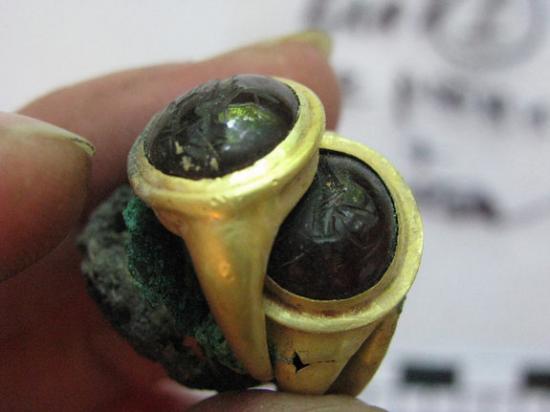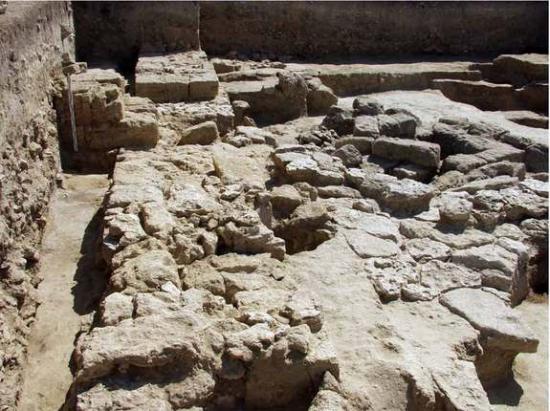Owen Jarus
Photos : Russian-Ukrainian Archaeological Artezian Expedition
Source - http://www.livescience.com/26150-buried-black-sea-treasure.html

Researchers working at the site of Artezian in the Crimea (Ukraine) have discovered two hoards of buried treasure (one hoard shown here) dating to A.D. 45, a time when the people of the citadel were under siege by the Roman army. Here, two silver anklets, beads, numerous coins and a white, glass flask with a two-headed face, one side serious and the other happy.
Residents of a town under siege by the Roman army about 2,000 years ago buried two hoards of treasure in the town's citadel — treasure recently excavated by archaeologists.

One of the hoards shown from a distance. Originally the treasures would have been inside wooden caskets that have since decomposed.
More than 200 coins, mainly bronze, were found along with "various items of gold, silver and bronze jewelry and glass vessels" inside an ancient fortress within the Artezian settlement in the Crimea (in Ukraine), the researchers wrote in the most recent edition of the journal Ancient Civilizations from Scythia to Siberia.

Among the discoveries from the hoards were gold rings with carved gemstones. They've been buried for nearly 2,000 years and a coin has apparently become stuck to this piece.
"The fortress had been besieged. Wealthy people from the settlement and the neighborhood had tried to hide there from the Romans. They had buried their hoards inside the citadel," Nikolaï Vinokurov, a professor at Moscow State Pedagogical University, explained.

The citadel
Artezian, which covered an area of at least 3.2 acres (1.3 hectares) and also had a necropolis (a cemetery), was part of the Bosporus Kingdom. At the time, the kingdom's fate was torn between two brothers —Mithridates VIII, who sought independence from Rome, and his younger brother, Cotys I, who was in favor of keeping the kingdom a client state of the growing empire. Rome sent an army to support Cotys, establishing him in the Bosporan capital and torching settlements controlled by Mithridates, including Artezian.

The people at Artezian had a fondness for sketching what we might consider "graffiti," as seen here.
People huddled in the fortress for protection as the Romans attacked, but Vinokurov said they knew they were doomed. "We can say that these hoards were funeral sacrifices. It was obvious for the people that they were going to die shortly," he wrote in an email to LiveScience. The siege and fall of the fortress occurred in AD 45.
Curiously, each hoard included exactly 55 coins minted by Mithridates VIII. "This is possibly just a simple coincidence, or perhaps these were equal sums received by the owners of these caskets from the supporters of Mithridates," the team wrote in its paper.
PART.2